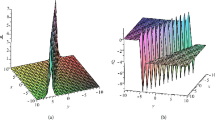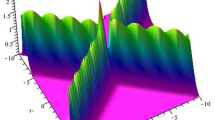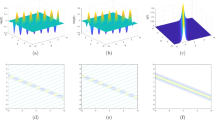Abstract
In this paper we discuss an improved Riemann–Hilbert method, by which arbitrary higher-order soliton solutions for the derivative nonlinear Schrödinger equation can be directly obtained. The explicit determinant form of a higher-order soliton which corresponds to one pth order pole is given. Besides the interaction related to one simple pole and the other one double pole is considered.
Similar content being viewed by others
Avoid common mistakes on your manuscript.
1 Introduction
The derivative-type nonlinear Schrödinger equations have several applications in plasma physics and nonlinear fiber optics. In plasma physics, the equation (also called DNLS-I)
describes small-amplitude nonlinear Alfvén waves propagating parallel to the ambient magnetic field [9, 13]. In nonlinear optics, the modified NLS i.e. the equation (1) plus the nonlinear term \(|q|^2{q}\) describes the case of subpicosecond optical pulses [3, 6]. Recently Moses et al. has experimentally demonstrated that the equation (also called DNLS-II)
describes the propagation of the self-steepening optical pulses without self-phase modulation [14]. In the view of inverse scattering theory they are gauge equivalent [23] to the following equation [7] (also called DNLS-III)
where the asterisk denotes the complex conjugate, so we take DNLS-III as an example to present our work. The above derivative-type equations are important integrable models. In addition, there are more general integrable generalizations, such as the high-order Kaup–Newell equation [18], the generalized mixed nonlinear Schrödinger equation [19], Kundu equation [11], Kundu–Eckhaus equation [5, 11]. Much research has been conducted for them, here we will not dwell on a detailed exposition of various results. The Eq. (3) are the compatible condition of the following linear differential equations
where
and the potential matrix
\(\sigma _3\) is one of the Pauli matrices
It is known that Zakharov first given higher-order solitons for the NLS equation corresponding to a double pole [24]. Subsequently higher-order solitons have also been studied for the modified KdV equation [22], the sine-Gordon equation [21] and so on. So far various methods have been developed to deal with higher-order solitons, for example the usual Riemann–Hilbert (RH) method [20], generalized Darboux transform [8, 12], \(\bar{\partial }\)-method [10], robust inverse scattering transform [4] et al.. In this paper, to avoid the difficulty of calculating residue conditions with multiple poles, different from the work [25, 26] we generalize Olmedilla’s idea [16] to the framework for RH method and arbitrary higher-order soliton solutions for the derivative nonlinear Schrödinger equation can be directly obtained.
This paper is arranged as follows. In Sect. 2, we summary the inverse scattering method for DNLS-III. In Sect. 3, we derive the explicit determinant form of a higher-order soliton which corresponds to one pth order pole. In Sect. 4, the interaction related to one simple pole and the other one double pole is displayed.
2 Summary of the Inverse Scattering Method for the DNLS Equation
Firstly, we summarize the already well-known results [15] for the DNLS-III that will be used in our study. In this section we solve the initial value problem for the DNLS-III with the following zero boundary condition (ZBC) at \(x\rightarrow \infty\):
meanwhile the complex function q(x) satisfies
2.1 The Direct Scattering Problem
2.1.1 Jost Solution and Analyticity
For the oriented curve \(\Sigma =\mathbb {R}\bigcup {\textrm{i}\mathbb {R}}\) (see Fig. 1) in complex \(\lambda\)-plane, we define \(J_{\pm }\) as the Jost solutions of the Lax representation (4) which obey the boundary conditions
Let
then
which is equivalent to Volterra integral equation
Denoting \(D_{\pm }=\{\lambda \in \mathbb {C}|\pm {\Re (\lambda )\Im (\lambda )>0}\}\), as shown in Fig. 1. By performing the Neumann series (cf. [1]) on the Volterra integral equations (8), we know that \(U_{-1}(J_{-1})\) and \(U_{+2}(J_{+2})\) can be analytically extended to \(D_{+}\) and continuously extended to \(D_{+}\bigcup \Sigma\), while \(U_{+1}(J_{+1})\) and \(U_{-2}(J_{-2})\) can be analytically extended to \(D_{-}\) and continuously extended to \(D_{-}\bigcup \Sigma\), where the subscripts 1 and 2 identify matrix columns, i.e., \(U_{\pm }=(U_{\pm 1},U_{\pm 2})\).
2.1.2 Scattering Matrix
Abel’s theorem implies that for any solution \(\psi (x,\lambda )\) of the Lax representation (4) one has \(\partial _{x}(\det {\psi })=0\). Since \(\mathop {\textrm{lim}}\nolimits _{x\rightarrow \pm \infty }{J_{\pm }}e^{\textrm{i}\lambda ^{2}\sigma _3{x}}=I\) for \(\lambda \in {\Sigma }\), we have
It follows that \(\forall \lambda \in \Sigma\) both \(J_{+}\) and \(J_{-}\) are two fundamental matrix solutions of the scattering problem (4). Define the scattering matrix S(k)
where \(S=\{s_{ij}\}\). Rewrite it by component
Furthermore we obtain
where W(f, g) is the Wronskian of f and g and reflection coefficients
From the analytic property of Jost solutions, \(s_{11}(\lambda )\) can be analytically extended to \(D_{+}\) and continuously extended to \(D_{+}\bigcup \Sigma\), while \(s_{22}(\lambda )\) can be analytically extended to \(D_{-}\) and continuously extended to \(D_{-}\bigcup \Sigma\).
2.1.3 Symmetry Conditions and Discrete Spectrum
By virtue of the uniqueness of the Jost solutions, we have the following symmetry conditions
So
and
If \(s_{11}(\lambda _{n})=0, n=1,\ldots ,N\), the eigenfunctions \(J_{-1}(x,\lambda )\) and \(J_{+2}(x,\lambda )\) at \(\lambda =\lambda _n\) must be proportional, i.e.
where \(\gamma _{n}\) is a complex valued constant. Owing to the relations (13), we have
then
where \(\hat{\gamma }_n=-\gamma _n, \check{\gamma }_n=\gamma _n^{*}, \tilde{\gamma }_n=-\gamma _n^{*}\). That is, the discrete spectrum is the set
This distribution is shown in Fig. 1.
2.1.4 Asymptotics as \(\lambda \rightarrow \infty\)
The Wentzel–Kramers–Brillouin (WKB) expansion can be used to derive the asymptotic of modified Jost solutions. In fact, we know that \(U_{\pm }\) are analytic in \(\mathbb {C}/\Sigma\), then we can write an asymptotic expansion for \(U_{\pm }\) when \(\lambda \rightarrow \infty\)
Substituting the above expansion into the Eq. (7) and utilizing the expressions for \(s_{11}\) and \(s_{22}\), we have
and
2.2 The Inverse Scattering Problem
2.2.1 Riemann–Hilbert Problem and Reconstruction Formula
In order to construct RH problem, introduce the sectionally meromorphic matrices
From the Eqs. (10) and (11) we obtain the jump condition
where
Recalling the asymptotic behavior of the scattering coefficients, it is easy to obtain that
From the Eq. (7) we can reconstruct the potential q(x, t) from the solution of the RH problem as follow
2.2.2 Residue Conditions and Solution for RHP
To solve the RHP, introduce the Cauchy projectors \(P^{\pm }\) over \(\Sigma\):
If \(f_{\pm }(\lambda )\) is analytic in the region \(D_{\pm }\) and \(f_{\pm }(\lambda )\rightarrow 0\) as \(|\lambda |\rightarrow \infty\), then
Furthermore, we can obtain the residue conditions from the equations (15) and (16)
where \(C_n=\frac{\gamma _{n}}{s^{\prime }_{11}(\lambda _n)}\).
Applying \(P^{-}\) to both sides of the expression (10) and \(P^{+}\) to both sides of the expression (11), meanwhile, taking advantage of the formulae (19) and the above residue conditions, we have
2.2.3 Time Evolution
The time evolution of the scattering data can be determined by the time part of the Lax representation (4). By the calculation (cf. [1] for details) we have
2.3 The Soliton Solutions for the DNLS Equation
We now consider the potential q(x, t) for which the reflection coefficient \(\rho (\lambda )\) vanishes. As usual, in the case there is no jump from \(M_{+}\) to \(M_{-}\) across the continuous spectrum, and the Eq. (20) reduce to an algebraic system. Next we take 1-soliton solution as an example.
Let \(\rho (\lambda )=\tilde{\rho }(\lambda )=0\) and \(N=1\). From the Eq. (20) and the formula (18), we can obtain 1-soliton solution
where
Remark 1
If we consider N different zeros of \(s_{11}(\lambda )\), By observation and calculation we can obtain the determinant form of N-soliton solution which is similar to the expression (29), this procedure will be elaborated in the next section.
3 Higher-Order Soliton Solutions for the DNLS Equation
In this section we generalize Olmedilla’s idea to the framework for RH method. If the potential q(x) decay rapidly enough at infinity, so that \(\rho (\lambda )\) can be analytically continued above or below all poles \(\{{\pm \lambda _n}\}_{n=1}^{N}\) and \(\tilde{\rho }(\lambda )\) can be analytically continued below or above all poles \(\{{\pm \lambda _n^{*}}\}_{n=1}^{N}\) ( cf. [1, 2]). The Eq. (20) can be simplified by virtue of the residue theorem as follows:
where \(\theta =\zeta ^2{x}+2\zeta ^4{t}\), \(\Gamma\) is the union of a contour from \(\infty\) to \(\textrm{i}\infty\) that passes above all poles \(\{\lambda _n\}_{n=1}^{N}\) and a contour from \(-\infty\) to \(-\textrm{i}\infty\) that passes below all poles \(\{-\lambda _n\}_{n=1}^{N}\), \(\bar{\Gamma }\) is the union of a contour from \(-\infty\) to \(\textrm{i}\infty\) that passes above all poles \(\{-\lambda ^{*}_n\}_{n=1}^{N}\) and a contour from \(\infty\) to \(-\textrm{i}\infty\) that passes below all poles \(\{\lambda ^{*}_n\}_{n=1}^{N}\) in the Fig. 1.
Supposing that \(\rho (\lambda )\) has a pth order pole, we consider the Laurent series expansion of \(\rho (\lambda )\) around the point \(\lambda _n\) in the region \(D_{+}\). From the symmetries (14), we have
where \(\rho _{0}(\lambda )\) and \(\tilde{\rho }_{0}(\lambda )\) are analytic and satisfy the symmetries (14), \(\rho _{-i}(i=1,2,\cdots ,p)\) is a constant. Plugging the expressions (23) into (22), the integral equations (22) can be rewritten as
For the case of a reflectionless potential, i.e. \(\rho (\lambda )=\tilde{\rho }(\lambda )=0\) when \(\lambda \in \Sigma\), the integral equation (24) and (25) reduce to the system of linear equations. By calculation we have
where \(\Omega =(F_{ij})_{p\times {p}}\) and \(F_{ij}\) is a \(2\times 2\) matrix. We denote
and
From the formula (18), we have
where
Using the expression (26) and (27), we obtain
The expression (28) can written into determinant form
where
Remark 2
If \(\rho (\lambda )\) has r different poles, \(\lambda _1,\lambda _2,\ldots ,\lambda _r\) in the region \(D_{+}\), and their order are \(p_1,p_2,\ldots ,p_r\) respectively. The process of dealing with the general case is similar to one pth order pole. To illustrate it we give an example of the interaction between one simple pole soliton and the other double pole soliton in the next section.
4 Example of the Solutions for DNLS Equation
4.1 The Double Soliton Solution
In this subsection we consider the soliton solution related to one double pole. Let
Substituting the expressions (30) into the Eqs. (24) and (25), we obtain
where
and
From the formula (29), we have
where
As shown in Fig. 2.
4.2 The Solution Related to One Simple Pole and the Other One Double Pole
In this subsection we consider the soliton solution related to one simplie pole and the other one double pole. Let
Plugging the expressions (33) into the Eqs. (24) and (25), we have
where
and
From the formula (29), we have
where
As shown in Fig. 3.
5 Conclusions and Discussions
We discussed the higher-order soliton solutions for DNLS-III equation by the improved Riemann–Hilbert method in detail. The main idea is to require the potentials q(x) decay rapidly enough at infinity so that the reflection coefficient \(\rho (\lambda )\) or \(\tilde{\rho }(\lambda )\) can be analytically extended to the region \(D_{\pm }\). For \(\rho (\lambda )\) has a pth order pole, by virtue of the Laurent series expansion of \(\rho (\lambda )\) we can obtain the explicit determinant form of higher-order soliton solutions. Moreover these results can be applied to the other derivative type NLS equations by gauge transform. In this paper the potentials q(x) is considered under the ZBC, we know that under the nonzero boundary condition (NZBC) it is more complicated to solve double soliton solutions by the usual RH method in the literature [17], in the near future we will generalize this idea to the NZBC case.
Data Availability
Data sharing does not apply to this article as no data sets were generated or analyzed during the current study.
References
Ablowitz, M.J., Prinari, B., Trubatch, A.D.: Discrete and Continuous Nonlinear Schrödinger Systems. Cambridge University Press, Cambridge (2004)
Ablowitz, M., Kaup, D., Newell, A.C., Segur, H.: The inverse scattering transform-Fourier analysis for nonlinear problems. Stud. Appl. Math. 53, 249–315 (1974)
Agrawal, G.P.: Nonlinear Fiber Optics. Academic Press, London (2007)
Bilman, D., Buckingham, R.: Large-order asymptotics for multiple-pole solitons of the focusing nonlinear Schrödinger equation. J. Nonlinear Sci. 29, 2185–229 (2019)
Calogero, F., Eckhaus, W.: Nonlinear evolution equations, rescalings, model PDEs and their integrability. I. Inverse Probl. 3, 229–262 (1987)
Doktorov, E.V.: The modified nonlinear Schrödinger equation: facts and artefacts. Eur. Phys. J. B 29, 227–231 (2002)
Gerdjikov, V.S., Ivanov, M.I.: The quadratic bundle of general form and the nonlinear evolution equations. I. Expansions over the “squared” solutions are generalized Fourier transforms. Bulg. J. Phys. 10, 13–26 (1983)
Guo, B., Ling, L., Liu, Q.P.: High-order solutions and generalized Darboux transformations of derivative nonlinear Schrödinger equations. Stud. Appl. Math. 130, 317–344 (2013)
Kaup, D.J., Newell, A.C.: An exact solution for a derivative nonlinear Schrödinger equation. J. Math. Phys. 19, 798–801 (1978)
Kuang, Y., Mao, B., Wang, X.: Higher-order soliton solutions for the Sasa–Satsuma equation revisited via \(\bar{\partial }\) method. J. Nonlinear Math. Phys. 30, 1821–1833 (2023)
Kundu, A.: Landau–Lifshitz and higher-order nonlinear systems gauge generated from nonlinear Schrödinger-type equations. J. Math. Phys. 25, 3433–3438 (1984)
Liu, S.Z., Zhang, Y.S., He, J.S.: Smooth positions of the second-type derivative nonlinear Schrödinger equation. Commun. Theor. Phys. 71, 357–361 (2019)
Mjølhus, E.: On the modulational instability of hydromagnetic waves parallel to the magnetic field. J. Plasma Phys. 16, 321–334 (1976)
Moses, J., Malomed, B.A., Wise, F.W.: Self-steepening of ultrashort optical pulses without self-phase-modulation. Phys. Rev. A 76, 021802 (2007)
Nie, H., Zhu, J., Geng, X.: Trace formula and new form of \(N\)-soliton to the Gerdjikov-Ivanov equation. Anal. Math. Phys. 8, 415–426 (2018)
Olmedilla, E.: Multiple pole solutions of the nonlinear Schrödinger equation. Phys. D 25, 330–346 (1987)
Pichler, M., Biondini, G.: On the focusing non-linear Schrödinger equation with non-zero boundary conditions and double poles. IMA J. Appl. Math. 82, 131–151 (2017)
Qiao, Z.: A new completeiy integrable Liouville’s system produced by the Kaup–Newell eigenvalue problem. J. Math. Phys. 34, 3110–3120 (1993)
Qiao, Z.: A hierarchy of nonlinear evolution equations and finite-dimensional involutive systems. J. Math. Phys. 35, 2971–2977 (1994)
Shchesnovich, V.S., Yang, J.: Higher-order solitons in the N-wave system. Stud. Appl. Math. 110, 297–332 (2003)
Tsuru, H., Wadati, M.: The multiple pole solutions of the sine-Gordon equation. J. Phys. Soc. Jpn. 53, 2908–2921 (1984)
Wadati, M., Ohkuma, K.: Multiple-pole solutions of the modified Korteweg–de Vries equation. J. Phys. Soc. Jpn. 51, 2029–2035 (1982)
Wadati, M., Sogo, K.: Gauge transformations in soliton theory. J. Phys. Soc. Jpn. 52, 394–398 (1983)
Zakharov, V.E., Shabat, A.B.: Exact theory of two-dimensional self-focusing and one-dimensional self-modulation of waves in nonlinear media. Sov. Phys. JETP 34, 62–69 (1972)
Zhang, Y., Tao, X., Xu, S.: The bound-state soliton solutions of the complex modified KdV equation. Inverse Probl. 36, 065003 (2020)
Zhang, Y., Wu, H., Qiu, D.: Revised Riemann–Hilbert problem for the derivative nonlinear Schrödinger equation: vanishing boundary condition. Theor. Math. Phys. 217, 1595–1608 (2023)
Acknowledgements
The comments and suggestions of the anonymous referee have been useful.
Funding
This work is supported by the National Natural Science Foundation of China (Grant No. 12001560) and Young Teacher Foundation of Zhongyuan University of Technology (No. 2020XQG17).
Author information
Authors and Affiliations
Contributions
YK and LT formally analyze and write original draft.
Corresponding author
Ethics declarations
Conflict of interest
The authors declare that they have no Conflict of interest.
Ethics Approval and Consent to Participate
Not applicable and All authors consent to participate.
Consent for publication
All authors consent for publication.
Additional information
Publisher's Note
Springer Nature remains neutral with regard to jurisdictional claims in published maps and institutional affiliations.
Rights and permissions
Open Access This article is licensed under a Creative Commons Attribution-NonCommercial-NoDerivatives 4.0 International License, which permits any non-commercial use, sharing, distribution and reproduction in any medium or format, as long as you give appropriate credit to the original author(s) and the source, provide a link to the Creative Commons licence, and indicate if you modified the licensed material. You do not have permission under this licence to share adapted material derived from this article or parts of it. The images or other third party material in this article are included in the article’s Creative Commons licence, unless indicated otherwise in a credit line to the material. If material is not included in the article’s Creative Commons licence and your intended use is not permitted by statutory regulation or exceeds the permitted use, you will need to obtain permission directly from the copyright holder. To view a copy of this licence, visit http://creativecommons.org/licenses/by-nc-nd/4.0/.
About this article
Cite this article
Kuang, Y., Tian, L. Higher-Order Soliton Solutions for the Derivative Nonlinear Schrödinger Equation via Improved Riemann–Hilbert Method. J Nonlinear Math Phys 31, 58 (2024). https://doi.org/10.1007/s44198-024-00228-7
Received:
Accepted:
Published:
DOI: https://doi.org/10.1007/s44198-024-00228-7







